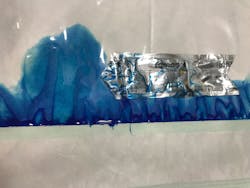Heat sealers: How to test and verify the sealing process
Q
Our facility got a new heat sealer because our old one was delivering bad seals. What are the requirements for testing this new piece of equipment?
A
As we know, all medical equipment can fail. Ensuring every piece of equipment within a medical device reprocessing department is working properly is vital to reducing patient infections. A properly functioning heat seal is essential because a proper seal will allow the peel pouch to provide a sterile barrier for the items placed in that pouch.
There are two major types of heat sealers used in a medical device reprocessing department: (See Figure 1)
- Push Bar Sealer - Impulse Sealers
- Continuous Feed - Roto-Sealers
- To achieve a proper seal, both types of sealers require three critical parameters to take place during the sealing process:
- Temperature
- Pressure
- Dwell time
Thus, checking that these critical parameters are happening each time is essential and should be tested (monitored) to ensure a proper seal. Newer models of heat sealers display the temperature and some even have alarms if the temperature varies a few degrees from the set temperature to help ensure a proper seal every time.
ANSI/AAMI has a few documents that we need to examine on verifying the seal on peel pouches. These documents are ISO/TS16775 and ISO 11607.
In ANSI/AAMI ST79, there is support for risk assessment if any failures occur within the sterilization process. Failed seals on peel pouches are a significant concern, and a way to decrease this is to verify the heat sealer is properly functioning. Thus, having a process in place with a verification test for the sealing function would be part of the department’s Quality Management System (QMS) and help reduce sealing failures caused by an improperly working heat sealer.
ANS/AAMI ST90 outlines the QMS process and the requirements for Performance Qualification (PQ). This process is what the user performs on all their equipment to verify that equipment is working correctly (in this case, a heat sealer). PQ is also concerned with obtaining and documenting that the equipment, as installed and operated per procedures, consistently performs following predetermined criteria and yields product meeting its specifications (a proper seal).
Next, we need to look at the standards of survey agencies, like The Joint Commission (TJC) standard E.C.06.2, which states that medical equipment is maintained, tested and inspected. All equipment within a medical device reprocessing department is tagged by the facility’s biomedical engineering department, which puts those pieces of equipment into the facility’s medical device inventory. The inventory would then include heat sealers within the reprocessing department because they have been tagged.
Within the TJC standard is Infection Control (IC) standard IC.02.02.01, which requires hospitals to reduce the risk of infections associated with medical equipment, devices, and supplies. Therefore, making sure a heat sealer works properly (providing a proper seal) fulfills this requirement. Remember that this process must be documented.
To determine if a heat sealer is working correctly, a medical device reprocessing department should institute a QMS for their heat sealer:
IQ
• Check-in process when the heat sealer arrives.
OQ
• Preventive maintenance program to ensure it is properly functioning and all work should be documented.
• Clinically relevant, evidence-based products for testing and verification of the seal:
° Seal tests
° Electrical testing
° Other tests
PQ
• Independent testing and verification of the heat-sealing process using clinically relevant, evidence-based products is key to reducing unsterile surgical instruments and hospital infections.
° Daily testing of equipment
° If a poor seal exists, then no sterile barrier is provided by the peel pouch (i.e., ensuring proper sealing).
° Staff training on use and testing of the heat sealer.
° Documentation of training and test results.
The method discussed in the standards for seal verification testing is an Ink Pouch test or the Dye leak penetration test for the routine testing of peel pouch sealing seams as per ISO 11607-1 and ASTM F1929. This Ink Pouch test or the Dye leak penetration test will show any irregularities that occur (e.g., channels of ink in the seal are a sign of a poor sealing process) and become visible immediately after the single-use dye test pack. It is easy to use, and the process can be documented. (See Figure 2). There are specific dye tests for TYVEK and paper plastic pouches.
Heat sealers do fail. Verifying your heat-sealing process with daily testing should be performed to help ensure a proper seal on peel pouches.
Many companies sell a dye test for heat sealers. Partner with a company that supports the idea of a QMS for testing your peel pouches and heat sealers. Ensuring your heat sealer provides the proper seal by simple daily verification tests fulfills the requirements outlined in the various standards presented and helps reduce the chance of a poorly sealed pouch and the possible risk of an unsterile medical device being used on a patient.
About the Author

Stephen M. Kovach
Stephen M Kovach, BS, CFER, started in the medical field in 1975 as a sterilization orderly and has worked in many positions within the Healthcare Industry. He presently is Clinical Educator Emeritus at Healthmark, A Getinge company.


